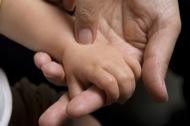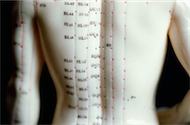

Traditional acupuncture is a system of diagnosis and treatment that has been in on-going development for 3000 years. It is a holistic approach to the management of disease as well as the maintenance of health. This means that the person is treated as a whole and symptoms are not seen in isolation.
The skill of an acupuncturist lies in their ability to make a traditional diagnosis from what is often a complex pattern of disharmony. The exact pattern and degree of disharmony is unique to each person. Thus with traditional acupuncture everyone will treated with an appropriate individual plan.
 Acupuncture is a safe treatment for all. It can be used safely alongside western medical treatment and drugs. For babies, children and some adults finger pressure rather than needles may be used.
Acupuncture is a safe treatment for all. It can be used safely alongside western medical treatment and drugs. For babies, children and some adults finger pressure rather than needles may be used.
Acupuncture is used to help with specific physical, psychological and emotional symptoms and these are considered within the context of life and medical history, character and family trends: -
 This initial consultation can last from 90 to 120 minutes. Judy makes a thorough assessment so that an individual diagnosis can be made according to traditional Chinese principles. Everything you say is completely confidential. This is an opportunity for you to give as much information as you can about your main problem. You will be asked how long you have had the problem, what makes it feel better or worse and the character of any pain that you might be feeling. You will be asked about your general health. That might include questions about your sleep patterns, digestion and emotional state.
This initial consultation can last from 90 to 120 minutes. Judy makes a thorough assessment so that an individual diagnosis can be made according to traditional Chinese principles. Everything you say is completely confidential. This is an opportunity for you to give as much information as you can about your main problem. You will be asked how long you have had the problem, what makes it feel better or worse and the character of any pain that you might be feeling. You will be asked about your general health. That might include questions about your sleep patterns, digestion and emotional state.
The practitioner will also discuss your medical history, details of previous treatment, your likes and dislikes in terms of food, climate, weather, social activity and exercise.
Diagnosis also includes an examination of blood pressure, pulse and tongue, which all yield further information about how you are functioning. If you are taking medicines prescribed by your GP, please continue to take these as usual, but bring details of them along to the initial consultation. Where appropriate you will also be given detailed, practical advice on diet and general lifestyle.
After the initial consultation treatment will then be tailored precisely to your individual needs, aiming to help with your complaints and restore a feeling of healthy balance. Treatments usually take forty-five minutes. There is usually no need to undress but wear loose comfortable clothes so that points can be accessed.
Very fine, sterile, disposable needles are used to carry out the treatment. These are not like those used in injections and blood tests. They are much finer and are solid rather than hollow. Thus treatment is generally comfortable. Needles are inserted either for a second or two, or left in place for up to 20 minutes, depending on the effect required. On average, anything from two to six needles may be used.
During a session, we may also use ‘Moxa', a herb used to warm acupuncture points, or apply glass cups to areas of pain. Gentle massage of areas of tension, particularly the neck and shoulders, may also form part of the treatment.
When a needle is inserted, the sensation is often described as a tingling or a dull ache.
Most people find that having acupuncture is a relaxing and pleasant experience and they generally feel calmer, noticing improvements to their health and energy in the days following a treatment.
Treatment usually begins on a weekly basis and, as symptoms improve, the sessions are spaced further apart. However each person’s treatment process is unique. The rate of improvement tends to depend on the individual rather than the complaint itself. As the treatment progresses the person might choose to come fortnightly, monthly, or seasonally. Many people opt to continue acupuncture for the ongoing support that the acupuncturist provides with stressful lives.
 Acupuncture works on the basis that our health is dependent on the flow of vital energy moving through the body in channels or meridians. When the body-mind energy is in balance and flowing smoothly, good physical and emotional health is maintained. On the other hand, pain or illnesses are the result of unbalanced energy.
Acupuncture works on the basis that our health is dependent on the flow of vital energy moving through the body in channels or meridians. When the body-mind energy is in balance and flowing smoothly, good physical and emotional health is maintained. On the other hand, pain or illnesses are the result of unbalanced energy.
The insertion of fine needles into specific locations on the body allows the flow of energy to be unblocked and balanced.
From Western medical point of view, acupuncture is thought to work by stimulating the nervous system to release chemicals such as endorphins and serotonins – and the chemicals help to change the experience of pain and stress. You don’t need to ‘believe’ in acupuncture for it to work.
Animals, who know nothing of the placebo effect and who have no expectations of treatment respond very well to acupuncture.